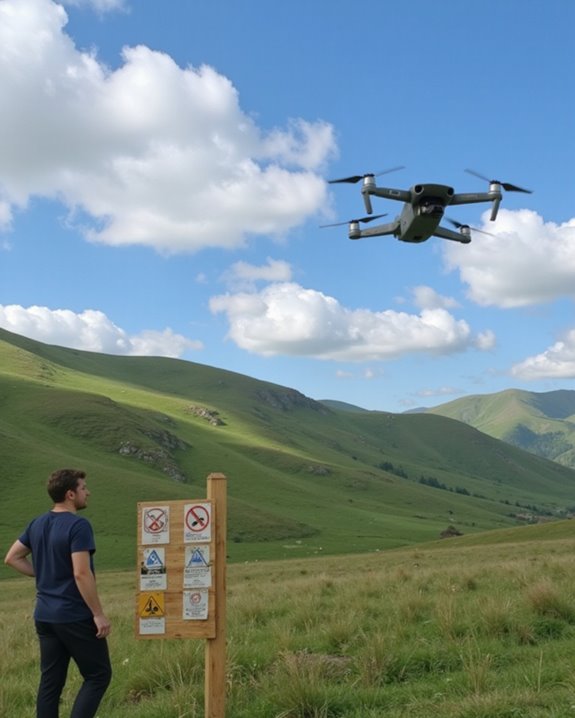Drone pilots cannot fly their aircraft anywhere they please. Federal regulations restrict flights above 400 feet, near airports, over crowds, and in national parks. Drones weighing over 250 grams require FAA registration, and operators must maintain visual line of sight at all times. Local laws add further limitations, including city parks and private property restrictions. Smart flyers check the B4UFLY app before takeoff to avoid hefty fines! The full landscape of drone regulations reveals important nuances for both recreational and commercial pilots.
Key Takeaways
- Drones cannot be flown anywhere – they’re restricted near airports, military bases, national parks, and critical infrastructure.
- Maximum allowed altitude is 400 feet above ground level in the U.S., with limited exceptions near structures.
- Visual line of sight must be maintained at all times without using binoculars or similar visual aids.
- Flying over people or moving vehicles is prohibited without special waivers or meeting specific requirements.
- Different rules apply to recreational versus commercial drone operators, with commercial use requiring Part 107 certification.
Understanding General Drone Altitude and Registration Requirements
When it comes to flying a drone, how high can you actually go? The answer is straightforward—400 feet above ground level is your ceiling in the U.S. This altitude measurement is from the surface directly beneath your drone, not sea level. Think of it as creating a safe buffer zone below where planes typically fly!
For drone owners, there’s more to remember than just altitude limits. All drones weighing over 250 grams (about the weight of a smartphone) must be registered with the FAA, with registration renewal required every three years. Your unique ID number must be visibly displayed on your aircraft, too.
One helpful exception to the height rule: you can fly higher than 400 feet when you’re within 400 feet of a structure—perfect for capturing those stunning skyscraper shots!
Additionally, to comply with FAA regulations, many drone users are adopting Remote ID modules that broadcast identification and location information during flight.
Visual Line of Sight Rules and Why They Matter
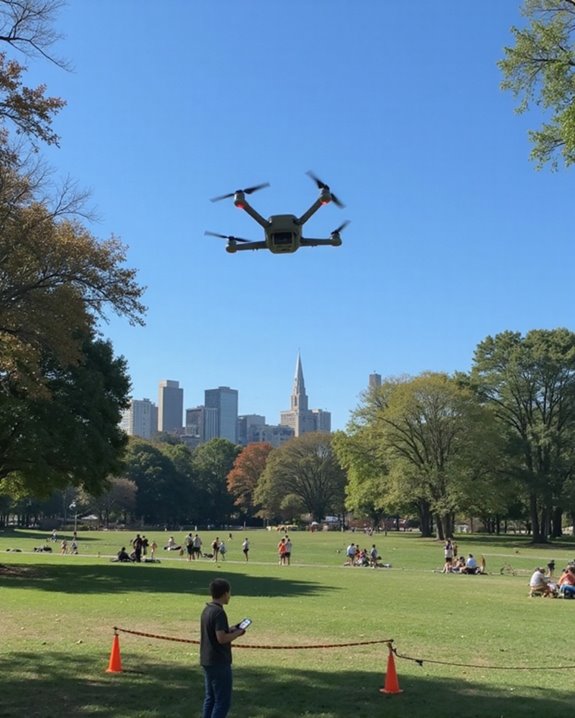
Beyond knowing your altitude limits, maintaining visual line of sight with your drone represents one of the most fundamental safety principles in drone operation. The FAA requires that you keep your drone visible at all times without using binoculars or other aids (corrective glasses are fine!). This isn’t just bureaucratic red tape—it’s about ensuring you can spot and avoid potential hazards immediately.
Visual Challenges increase dramatically when flying in changing weather or at dusk, making continuous observation vital. If you’re working with a team, effective Observer Communication becomes essential, with visual observers needing to be physically near you and in direct contact. Remember, those fancy FPV goggles might give you an amazing drone’s-eye view, but they don’t satisfy FAA requirements without a proper waiver! Many professional drones also include GPS tracking features to help maintain orientation and position during flight.
Restricted Areas and No-Fly Zones for Drone Pilots
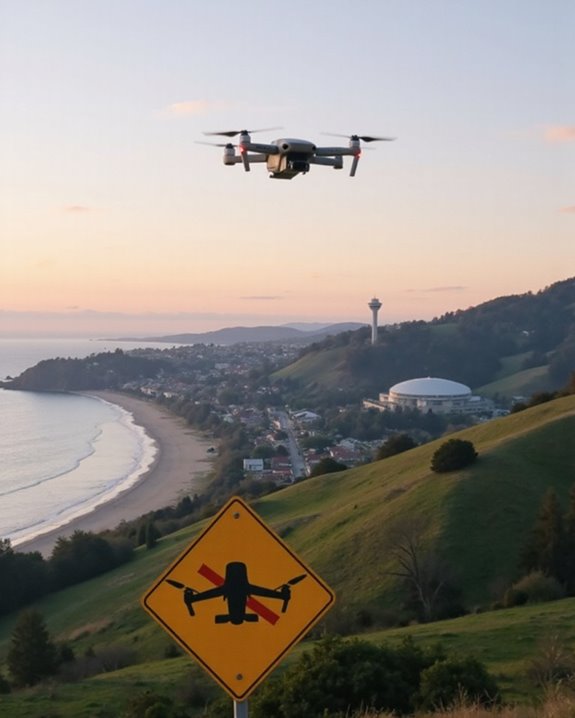
Where you can safely fly your drone isn’t just a matter of preference—it’s heavily regulated for everyone’s safety and security. Permanent no-fly zones include airports, military bases, and critical infrastructure like power plants. National Parks and Heritage Sites are typically off-limits too, preserving these treasured locations from aerial disturbances!
Temporary Flight Restrictions (TFRs) pop up around major sporting events, presidential movements, and even Maritime Zones during special operations. Don’t forget that local governments can establish their own no-drone zones near schools, government buildings, and public spaces.
The FAA’s B4UFLY app is your best friend for checking restrictions before launch. Remember, violating these rules isn’t just inconvenient—it can result in hefty fines and penalties. Always research before you fly! Additionally, commercial drone pilots must obtain FAA certification to operate legally within regulated airspace.
Recreational vs. Commercial Drone Flight Permissions
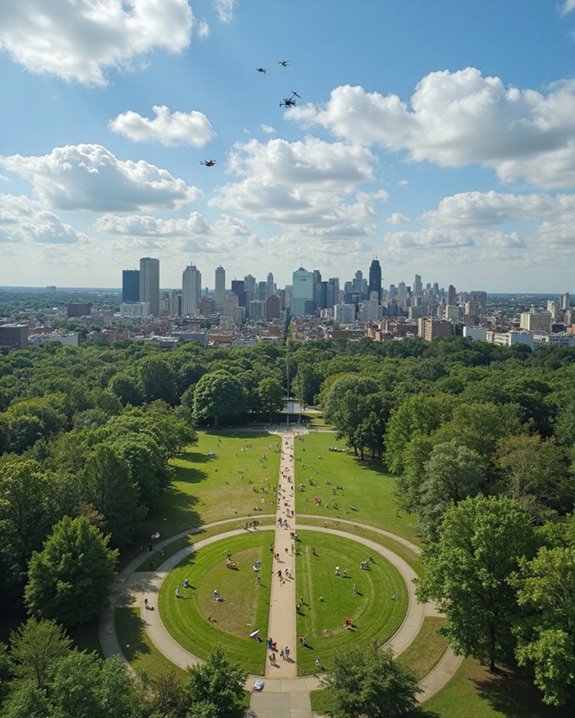
Understanding the difference between recreational and commercial drone flights marks a critical distinction in the drone world! The FAA has established separate pathways for each type of flyer, with substantially different requirements.
Commercial pilots must be at least 16 years old, demonstrate English Language Proficiency, and pass a TSA background check before obtaining their Part 107 certification. Recreational flyers, however, face fewer hurdles! There’s no minimum age for obtaining a TRUST certificate, and no English requirements apply.
Both groups must maintain visual line of sight and follow airspace rules, but commercial pilots enjoy more flexibility through waivers. Want to fly over people or at night? A Part 107 certificate with proper lighting opens those doors! Remember, if you’re compensated for your flight—even as a volunteer—you’re officially in commercial territory.
Flying Over People and Vehicles: What’s Allowed
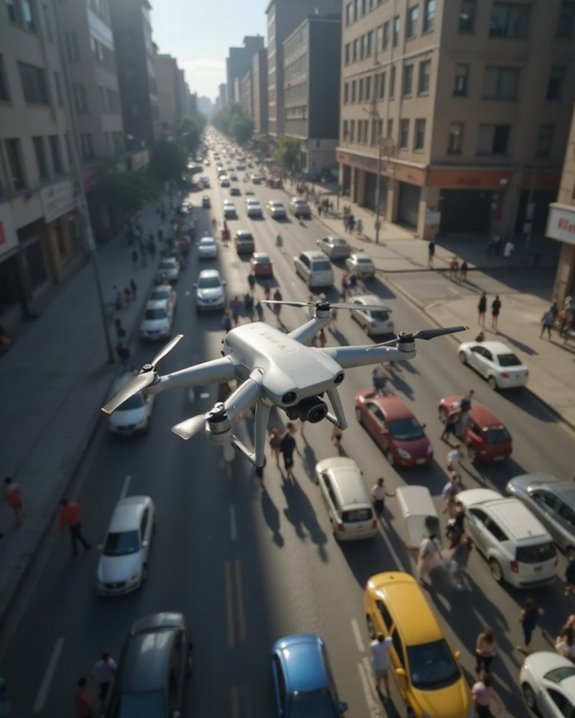
Flying directly over people or vehicles with your drone presents one of the trickiest aspects of drone operation that pilots must navigate! FAA Part 107 regulations generally prohibit flying directly over people unless they’re under a covered structure or inside a stationary vehicle that provides protection from potential People Hazards.
When it comes to Vehicle Risks, the rules are even stricter. Operations over moving vehicles are typically not allowed without a waiver, as a drone could startle drivers or cause accidents if it were to fall! Only drones categorized under Section 107.145 (Categories 1-4) may operate over moving vehicles under specific conditions.
State-Specific Drone Regulations to Consider
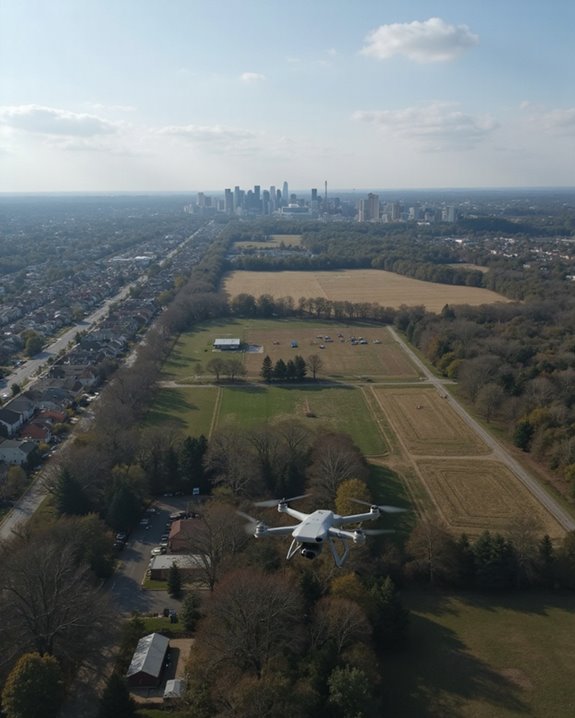
Beyond the federal airspace rules, each state across America has developed its own unique patchwork of drone regulations that pilots must carefully navigate! For example, some states have implemented strict Liability Rules that hold drone operators fully responsible for any damages or privacy violations. These can vary dramatically from the relatively relaxed guidelines in rural states to stringent restrictions in more populated regions.
Several states have also begun introducing Insurance Mandates for drone operators, particularly for commercial flights. In California, you’ll find extensive privacy protections, while Florida focuses on wildlife protection measures. Before launching your drone in a new state, always check UAV Coach’s state-specific resources! Remember, compliance isn’t just about avoiding fines — it’s about respecting local communities and maintaining the good reputation of drone enthusiasts everywhere.
Traveling With Your Drone: Airport and Airline Guidelines
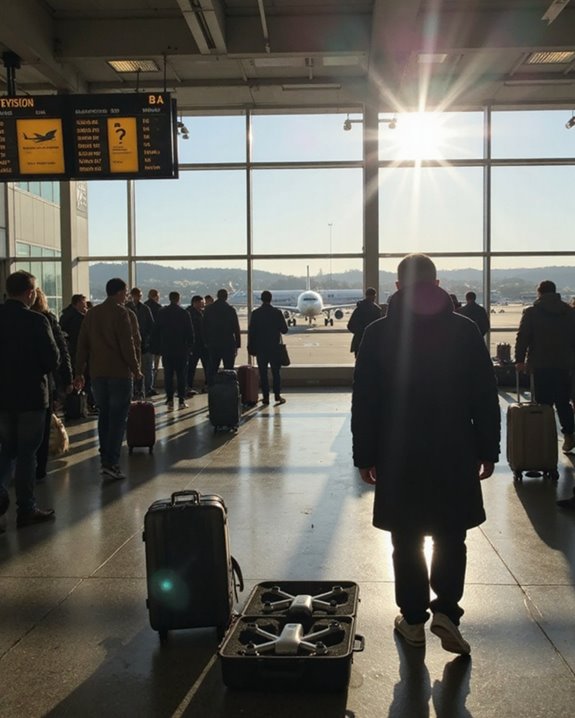
When planning drone adventures beyond your home state, travelers must next navigate the complex world of airport and airline regulations! While drones are permitted in carry-on luggage, proper preparation is essential. Airlines enforce strict Battery Rules for lithium-powered devices, often limiting capacity and requiring special storage procedures to prevent accidental activation.
Smart Packing Tips include using hard cases with foam inserts, removing batteries from the drone body, and covering terminal ends with tape. Remember to notify your airline about your drone before check-in, which can greatly streamline the security screening process. TSA allows drones through checkpoints, but components may require separate screening.
The most prepared drone travelers check airline policies in advance—your magnificent flying machine deserves the same careful handling as your vacation itinerary!
Future Regulatory Changes That Will Affect Where You Can Fly
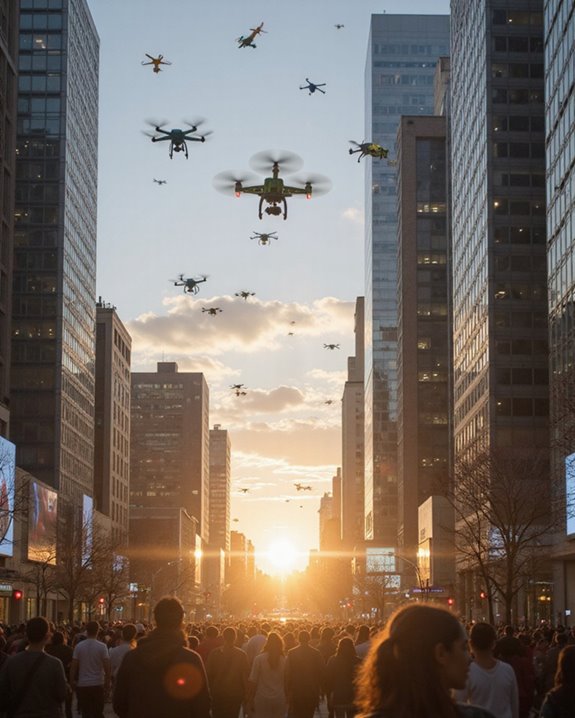
What does the regulatory horizon look like for drone enthusiasts and professionals alike? The FAA’s upcoming Part 108 rules (expected in 2025) will dramatically reshape drone operations, especially for Beyond Visual Line of Sight flights. These changes will open exciting possibilities while imposing stricter requirements!
International Rules are becoming increasingly standardized, with enhanced remote ID requirements and more sophisticated no-fly zones. Drone pilots should prepare for dynamic airspace restrictions that can change in real-time during emergencies or events. Additionally, Eco Restrictions protecting wildlife habitats and sensitive natural areas are gaining traction worldwide.
The future balances opportunity with responsibility—commercial operators will gain BVLOS capabilities but face more detailed tracking requirements, while recreational flyers will need to navigate more defined flying areas. Get ready for a more connected, regulated airspace!
Frequently Asked Questions
Can I Fly My Drone at Night?
Operators can fly drones at night under Part 107 rules without a waiver, provided their aircraft has anti-collision lights meeting Night Lighting requirements with three-mile Visibility Rules for safety compliance.
Are There Weather Restrictions for Drone Flights?
Like a bird unable to navigate through blinding fog, drone operators face strict weather restrictions. FAA rules require three-mile visibility, 500-foot cloud clearance, and consideration of wind restrictions. Fog guidelines prohibit flights in conditions obscuring visibility.
How Do I Legally Fly Drones Near Wildlife?
Operators should maintain significant distance from wildlife to avoid animal disturbance. Conservation rules prohibit harassment, pursuing, or disrupting wildlife. Pilots must research local regulations, maintain at least 100 feet clearance, and cease operations if animals show distress.
What Insurance Do I Need for My Drone?
Operators should consider liability coverage to protect against third-party injuries or property damage. Premium options include annual policies for frequent flyers or on-demand insurance starting around $7/hour for occasional use.
Can I Fly Drones in National Parks?
Drones are prohibited in national parks by NPS regulations. No launching, landing, or operation is allowed, even for scenic photography or at historical sites, without special permits for research or management activities.

